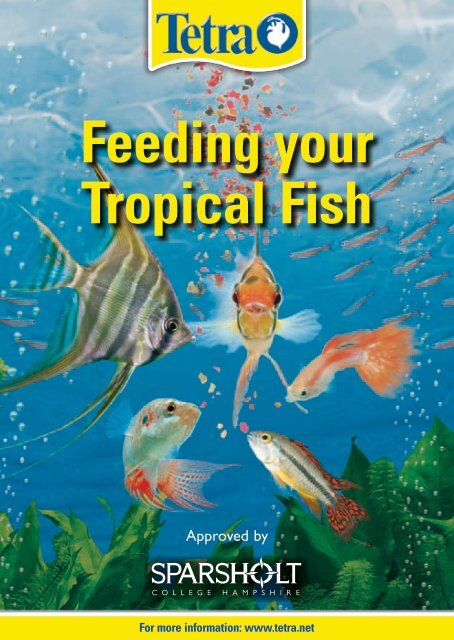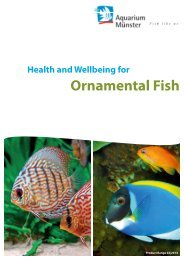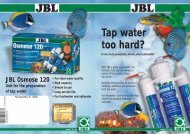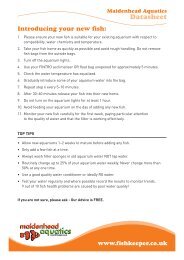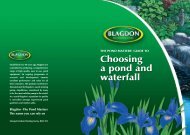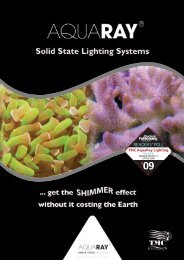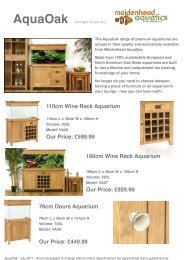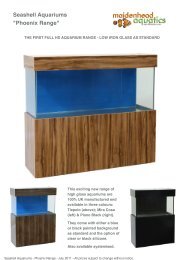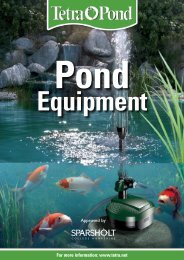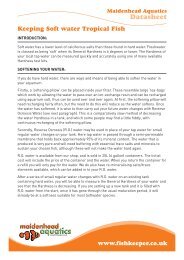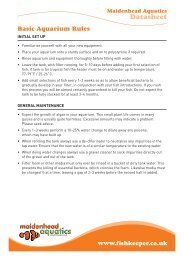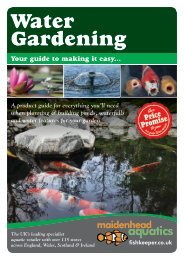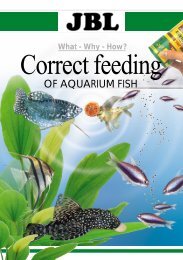You also want an ePaper? Increase the reach of your titles
YUMPU automatically turns print PDFs into web optimized ePapers that Google loves.
<strong>Feeding</strong> <strong>your</strong><br />
<strong>Tropical</strong> <strong>Fish</strong><br />
Approved by<br />
For more information: www.tetra.net
The importance of a good quality diet<br />
Feed <strong>your</strong> fish<br />
2-3 times a<br />
day, only as<br />
much as they<br />
can eat in a<br />
few minutes.<br />
2<br />
In their natural environment<br />
most fish consume a wide<br />
variety of foods, such as<br />
algae, plants, crustaceans,<br />
insects, and other fish. This<br />
ensures they receive a<br />
balanced diet, which needs<br />
to be replicated in captivity<br />
to keep them healthy.<br />
Thanks to <strong>Tetra</strong> this is<br />
easy, as every one of our<br />
foods has been carefully<br />
formulated and tested to<br />
ensure it supplies exactly<br />
the right quality and quantity<br />
of nutrients that fish need.<br />
In fact, <strong>Tetra</strong> developed the<br />
very first complete tropical<br />
food – <strong>Tetra</strong>Min – over 55<br />
years ago.<br />
<strong>Feeding</strong> a good quality<br />
<strong>Tetra</strong> food is important<br />
because it will improve<br />
<strong>your</strong> enjoyment of <strong>your</strong><br />
aquarium:<br />
• It keeps the water<br />
cleaner and clearer, and<br />
makes the aquarium<br />
easier to maintain,<br />
by reducing waste<br />
production.<br />
• It keeps the<br />
fish healthier and<br />
more colourful, by<br />
providing better quality<br />
nutrients in the correct<br />
concentrations.<br />
• It helps to control<br />
algae, by reducing the<br />
production of dissolved<br />
nutrients.<br />
<strong>Tetra</strong> foods are formulated<br />
and tested to minimise waste<br />
production, ensuring that the<br />
fish receive more nutrition<br />
and that the aquarium is<br />
easier to look after.
Different feeding needs<br />
There is a wide range of<br />
fish available for tropical<br />
aquariums, many of which<br />
have different feeding<br />
needs. Generally fish tend to<br />
feed at the surface, in midwater,<br />
or from the bottom<br />
of the aquarium. If you take<br />
a close look at <strong>your</strong> fish<br />
you can often identify their<br />
feeding preference from<br />
the position of their mouth.<br />
If it is upturned then they<br />
are surface feeders; if it<br />
is forward-facing they are<br />
mid-water feeders; and if it is<br />
downward-facing they feed<br />
from the bottom.<br />
To ensure that all of <strong>your</strong> fish<br />
get the nutrition they need,<br />
it is important to feed foods<br />
that are appropriate for their<br />
feeding behaviour. Because<br />
of this, <strong>Tetra</strong> has foods to<br />
cater for all of<br />
<strong>your</strong> fishes’ feeding<br />
preferences.<br />
Shape of Mouth Types of food<br />
Upturned<br />
(Surface feeder)<br />
Forward facing<br />
(Mid-water<br />
feeder)<br />
Downward-facing<br />
(Bottom<br />
feeder)<br />
• Flakes/Crisps<br />
• Sticks<br />
(larger fish)<br />
• Flakes/Crisps<br />
• Slow-sinking<br />
Granules<br />
• Slow-sinking<br />
Granules<br />
• Tablets/Wafers<br />
3
Foods correctly<br />
formulated for<br />
tropical fish will<br />
significantly<br />
improve their<br />
health<br />
All <strong>Tetra</strong>Min<br />
foods contain<br />
patented<br />
ActiveFormula,<br />
to maintain<br />
a strong and<br />
healthy immune<br />
system.<br />
4<br />
Complete daily foods<br />
The main part of <strong>your</strong> fishes’<br />
diet should be made up of<br />
a complete food such as<br />
<strong>Tetra</strong>Min. <strong>Tetra</strong>’s main daily<br />
foods have been formulated<br />
to cater for the nutritional<br />
needs of a wide range of<br />
species, typically found in<br />
aquariums. They should be<br />
fed 2-3 times a day giving<br />
as much as the fish can eat<br />
within a few minutes.<br />
<strong>Tetra</strong>Min Flakes<br />
For clear water and healthy<br />
fish, <strong>Tetra</strong>Min contains<br />
all the vitamins and other<br />
nutrients fish need, in a<br />
highly digestible format.<br />
<strong>Tetra</strong>Min is the world’s bestselling<br />
tropical fish food, and<br />
is the product of over 55 years<br />
of research and development.<br />
<strong>Tetra</strong>Min Crisps<br />
For an aquarium that is even<br />
healthier and easier to care<br />
for, Crisps represent the next<br />
generation of fish foods.<br />
Crisps offer a number of<br />
advantages over flakes:<br />
• Even cleaner, clearer<br />
water, and reduced<br />
maintenance, thanks to a<br />
patented low-temperature<br />
extrusion process that<br />
results in less waste<br />
compared to flakes.<br />
• Improved fish condition,<br />
due to low-temperature<br />
cooking process that<br />
preserves more vitamins<br />
and nutrients.
Feed <strong>Tetra</strong>Min Crisps instead<br />
of <strong>Tetra</strong>Min Flakes, as the<br />
main part of the diet.<br />
<strong>Tetra</strong>Min Baby<br />
<strong>Tetra</strong>Min Baby offers very<br />
small fish all the benefits of<br />
<strong>Tetra</strong>Min in a finely milled<br />
<strong>Tetra</strong>Pro Premium Daily Foods<br />
If you want to give <strong>your</strong> fish<br />
the very best food available,<br />
then choose <strong>Tetra</strong>Pro Crisps<br />
for their main daily diet. As<br />
well as all the benefits of<br />
Crisp Technology, including<br />
clearer water and healthier<br />
fish, <strong>Tetra</strong>Pro offers fish a<br />
‘two-in-one’ food. Each crisp<br />
delivers a complete diet with<br />
everything <strong>your</strong> fish need,<br />
plus a concentrated additional<br />
benefit. Feed <strong>Tetra</strong>Pro instead<br />
of <strong>Tetra</strong>Min Flakes or <strong>Tetra</strong>Min<br />
Crisps, to provide <strong>your</strong> fish with<br />
the very best diet possible.<br />
<strong>Tetra</strong>Pro<br />
Premium daily food for<br />
excellent health and condition,<br />
with Energy Crisps containing<br />
a concentrated<br />
source of high quality<br />
proteins and healthy<br />
omega-3 fatty acids.<br />
particle. It contains additional<br />
proteins and energy to<br />
promote excellent growth,<br />
and is ideal for feeding to<br />
fish up to 1cm in length. After<br />
this they should be fed on<br />
crushed or whole <strong>Tetra</strong>Min<br />
Flakes or Crisps.<br />
<strong>Tetra</strong>Pro Colour<br />
Premium daily food with<br />
concentrated carotenoids<br />
to strengthen the natural<br />
colours of <strong>your</strong> fish. Improved<br />
colouration is noticeable after<br />
just two weeks feeding.<br />
<strong>Tetra</strong>Pro Vegetable<br />
Premium daily food with<br />
concentrated Spirulina algae<br />
and vegetable proteins, to<br />
maintain a healthy immune<br />
system. Also ideal for feeding<br />
to fish that enjoy<br />
some vegetable<br />
matter in their<br />
diet, e.g. Lake<br />
Malawi cichlids,<br />
mollies,<br />
barbs and<br />
gouramis.<br />
<strong>Tetra</strong>Pro<br />
foods result in<br />
cleaner water,<br />
healthier<br />
fish, plus<br />
they deliver<br />
a specific<br />
concentrated<br />
benefit<br />
5
<strong>Feeding</strong> time<br />
provides<br />
an ideal<br />
opportunity<br />
to observe<br />
<strong>your</strong> fish and<br />
check they<br />
are healthy<br />
6<br />
Treats for <strong>your</strong> fish<br />
Just like all animals, fish<br />
enjoy the occasional treat<br />
to add variety to their diet.<br />
These should be fed 3-4<br />
times a week, in place of <strong>your</strong><br />
fishes’ normal food. With<br />
<strong>Tetra</strong> treat foods you can<br />
deliver this variety in a format<br />
that they enjoy, and that is<br />
also good for them.<br />
<strong>Tetra</strong> FreshDelica<br />
<strong>Tetra</strong> FreshDelica is a fresh,<br />
natural treat food that fish<br />
love, in a format that is<br />
convenient and easy to use.<br />
• 3 varieties<br />
– Bloodworms, Daphnia,<br />
and Brine Shrimp<br />
• Fresh, healthy treat<br />
preserved in a vitamin<br />
enriched gel.<br />
<strong>Tetra</strong>Treats Tablets<br />
<strong>Tetra</strong>Treats Tablets are made<br />
using a variety of natural<br />
foods, including Daphnia,<br />
Brine Shrimp, Gammarus,<br />
and Bloodworms. They are<br />
a nutritious treat that can<br />
be stuck onto the aquarium<br />
glass, enabling you to enjoy<br />
watching <strong>your</strong> fish feed.<br />
• Convenient – does not<br />
need to be kept in the<br />
fridge or freezer, and has<br />
a long shelf life for easier<br />
storage.<br />
• No mess – portion-sized<br />
sachets can simply<br />
be squeezed into the<br />
aquarium
Going on Holiday<br />
<strong>Fish</strong> require a regular supply<br />
of food to remain in good<br />
condition, and many people<br />
worry about how to provide<br />
this when they are not at<br />
home. Fortunately, <strong>Tetra</strong><br />
has developed a number of<br />
convenient holiday foods,<br />
to keep fish healthy until<br />
<strong>your</strong> return. Simply add the<br />
required amount before<br />
leaving, and <strong>your</strong> fish will<br />
need no additional food while<br />
you are away.<br />
<strong>Tetra</strong>Min Holiday – for<br />
longer breaks<br />
A patented gel-based holiday<br />
food containing Daphnia with<br />
added vitamins and minerals.<br />
Unlike plaster-based holiday<br />
foods, it is 100% edible and<br />
will not alter the chemistry of<br />
the aquarium water. Simply<br />
put the required number<br />
of holiday blocks into <strong>your</strong><br />
aquarium to feed fish for up<br />
to 14 days.<br />
<strong>Tetra</strong>Min Weekend Sticks<br />
– for short breaks<br />
A 100% edible food that<br />
provides all of <strong>your</strong> fishes’<br />
nutritional needs during short<br />
breaks. Unlike plaster-based<br />
holiday foods, they will not<br />
cloud the water or alter its<br />
chemistry.<br />
7
Your aquatics<br />
outlet can give<br />
you more advice<br />
on the right<br />
type of food for<br />
different fish.<br />
8<br />
Foods for different fish<br />
To cater for the wide range<br />
of feeding preferences<br />
and behaviours found in<br />
fish, <strong>Tetra</strong> has developed a<br />
range of special tropical fish<br />
foods. These should be fed<br />
in addition to a daily food<br />
such as <strong>Tetra</strong>Min, depending<br />
on what types of fish <strong>your</strong><br />
aquarium contains.<br />
Food for mid-water feeders<br />
<strong>Fish</strong> that feed in mid-water<br />
prefer a sinking food. If <strong>your</strong><br />
aquarium contains small midwater<br />
fish, such as <strong>Tetra</strong>s and<br />
Harlequins, they will benefit<br />
from slow-sinking <strong>Tetra</strong>Prima<br />
Mini Granules.<br />
For larger mid-water feeders,<br />
such as Angelfish, feed<br />
<strong>Tetra</strong>Prima. These provide<br />
a larger granule which also<br />
sinks slowly through the<br />
water column. It is likely that<br />
<strong>your</strong> aquarium will contain<br />
a mixture of surface and<br />
mid-water feeders, which<br />
means you should feed a<br />
combination of a staple<br />
flake or crisp (e.g. <strong>Tetra</strong>Min<br />
Crisps), and a slow-sinking<br />
granule (e.g. <strong>Tetra</strong>Prima).<br />
Food for bottom feeders<br />
Most aquariums contain<br />
some bottom-feeding<br />
fish, such as Corydoras<br />
catfish, Clown loach, and<br />
Plecostomus catfish. These<br />
fish do not rise to the surface<br />
to feed, and therefore require<br />
a sinking food.<br />
For active bottom-feeding<br />
fish, such as Clown loach,<br />
<strong>Tetra</strong>Prima can provide a<br />
suitable diet. However, it<br />
is important to make sure<br />
that they receive enough<br />
granules, as other fish will<br />
consume them as they sink.<br />
For most bottom-feeders, it<br />
will be necessary to feed a<br />
tablet or wafer food. These<br />
are designed to sink rapidly,<br />
and provide food in a compact<br />
format that the fish can graze<br />
on. This prevents other fish<br />
from eating it first.
<strong>Tetra</strong> TabiMin Tablets and<br />
<strong>Tetra</strong> Variety Wafers both<br />
provide a complete diet for<br />
bottom feeding fish. Variety<br />
Wafers are ideal for fish that<br />
are shy and not as quick<br />
to feed.<br />
For Plecostomus catfish<br />
(“sucker-mouth” catfish,<br />
e.g. Ancistrus) it is<br />
important to feed a food<br />
containing vegetable<br />
ingredients. This matches<br />
their natural diet which<br />
is rich in algae. <strong>Tetra</strong><br />
PlecoMin tablets are<br />
ideal for active species<br />
of Plecostomus, whilst<br />
<strong>Tetra</strong> PlecoWafers<br />
are perfect for shy or<br />
nocturnal individuals.<br />
<strong>Tetra</strong> PlecoWafers are<br />
designed to remain in-tact<br />
for a long period of time,<br />
and allow Plecostomus to<br />
graze naturally.<br />
Sinking wafers or tablets<br />
should be used alongside<br />
other types of food. For very<br />
shy or nocturnal species, they<br />
can also be added after the<br />
lights have been turned out.<br />
Food for large tropical fish<br />
Larger tropical fish prefer<br />
a larger food type, as it<br />
is easier for them to consume.<br />
<strong>Tetra</strong> DoroMin provides<br />
a complete diet in stick<br />
format, for larger species<br />
such as Oscars, Tinfoil barbs,<br />
and Severums. DoroMin can<br />
be fed to large fish instead<br />
of a staple<br />
flake or crisp.<br />
The right<br />
selection<br />
The correct mix of<br />
foods for <strong>your</strong> fish will<br />
depend on the species you<br />
have. You will probably<br />
find that you need to<br />
feed a combination of<br />
flakes / crisps, granules,<br />
and wafers / tablets at each<br />
mealtime. This will ensure<br />
that all the fish get a<br />
balanced diet.<br />
9
10<br />
Stocking & <strong>Feeding</strong> Examples<br />
Part of the enjoyment of<br />
owning fish is that <strong>your</strong><br />
aquarium is unique, as it<br />
is based on <strong>your</strong> personal<br />
choice of décor, fish and<br />
plants. When deciding<br />
what to keep in <strong>your</strong><br />
aquarium, it is important<br />
to ensure that the fish mix<br />
well, that they are kept in<br />
the correct numbers, and<br />
that any special water<br />
chemistry requirements<br />
are met. Fortunately, this is<br />
straightforward, especially<br />
if you choose ‘community’<br />
fishes – i.e. those that live<br />
peacefully together. Most<br />
of these fishes are also<br />
tolerant of different water<br />
conditions, meaning that<br />
they can be kept in most<br />
aquariums. When creating<br />
<strong>your</strong> community aquarium,<br />
it is important to ask <strong>your</strong><br />
aquatics specialist for<br />
advice on suitable fish and<br />
plants, and what foods they<br />
require. In this section we<br />
give you some ideas about<br />
possible combinations and<br />
what foods are needed<br />
to keep them healthy. You<br />
can either follow these or<br />
choose <strong>your</strong> own, it’s up<br />
to you!
Community Aquarium (Asia)<br />
Shoaling fish add life and<br />
movement to the aquarium,<br />
whilst colourful Dwarf<br />
gouramis and Siamese<br />
fighting fish provide a focal<br />
point. Kuhli loach add interest<br />
to the base of the aquarium.<br />
Main Foods<br />
<strong>Tetra</strong>Min Flakes or Crisps.<br />
Other Foods<br />
<strong>Tetra</strong>Prima Mini Granules<br />
<strong>Tetra</strong> TabiMin<br />
Treat Foods<br />
<strong>Tetra</strong> Fresh Delica<br />
Bloodworm, Daphnia, or<br />
Brine Shrimp<br />
3<br />
1<br />
5<br />
2<br />
4<br />
1<br />
2<br />
3<br />
4<br />
5<br />
Suggested fish<br />
species<br />
Zebra Danio<br />
(Danio rario)<br />
Lively shoaling<br />
fish<br />
Siamese<br />
Fighting<br />
<strong>Fish</strong> (Betta<br />
splendens)<br />
Only keep one<br />
male, as two<br />
will fight<br />
Dwarf Gourami<br />
(Colisa lalia)<br />
Usually bought<br />
in pairs (male<br />
& female)<br />
Harlequin<br />
Rasbora<br />
(Trigonostigma<br />
heteromorpha)<br />
Colourful<br />
shoaling fish<br />
Kuhli Loach<br />
(Pangio kuhlii)<br />
Colourful,<br />
shoaling bottomfeeding<br />
fish<br />
11
1<br />
2<br />
3<br />
4<br />
5<br />
Suggested fish<br />
species<br />
Ram cichlid<br />
(Mikrogeophagus<br />
ramirezi)<br />
Colourful species<br />
with lots of<br />
character; keep<br />
in a pair<br />
Angelfish<br />
(Pterophyllum<br />
scalare)<br />
Impressive focal<br />
point for larger<br />
aquariums; keep<br />
in small groups<br />
Pristella tetra<br />
(Pristella<br />
maxillaries)<br />
Lively, peaceful<br />
shoaling fish<br />
Royal Panaque<br />
(Panaque<br />
nigrolineatus)<br />
Colourful and<br />
impressive<br />
Plecostomus for<br />
larger aquariums<br />
(90cm<br />
or more)<br />
Corydoras<br />
catfish<br />
(Corydoras spp.)<br />
Lively, shoaling<br />
bottom feeders<br />
12<br />
1<br />
3<br />
5<br />
2<br />
4<br />
Community Aquarium<br />
(South America)<br />
Most of the fish we keep<br />
originate from the tropical<br />
regions of South America.<br />
These include lively, shoaling<br />
tetras, colourful cichlids, and<br />
interesting catfish.<br />
Main Foods<br />
<strong>Tetra</strong>Min Flakes / Crisps<br />
Other Foods<br />
<strong>Tetra</strong> PlecoWafers<br />
<strong>Tetra</strong> TabiMin Tablets or<br />
<strong>Tetra</strong> Variety Wafers<br />
<strong>Tetra</strong>Prima<br />
Treat Foods<br />
<strong>Tetra</strong> FreshDelica Bloodworm<br />
<strong>Tetra</strong>Treats Tablets
Discus Aquarium<br />
If you have some<br />
experience with community<br />
fish, and want more of<br />
a challenge, Discus are<br />
extremely impressive<br />
fish. They require softer,<br />
more acidic water, and a<br />
temperature of 27-29˚C or<br />
higher. You should ask <strong>your</strong><br />
aquatics specialist about<br />
creating the right water<br />
conditions to keep them<br />
healthy.<br />
Main Foods<br />
<strong>Tetra</strong>Pro Colour<br />
<strong>Tetra</strong>Prima<br />
Other Foods<br />
<strong>Tetra</strong> TabiMin Tablets or<br />
<strong>Tetra</strong> Variety Wafers<br />
Treat Foods<br />
<strong>Tetra</strong> FreshDelica<br />
Bloodworm<br />
3<br />
1<br />
4<br />
2<br />
1<br />
2<br />
3<br />
4<br />
Suggested <strong>Fish</strong><br />
Species<br />
Discus<br />
(Symphysodon<br />
aequifasciatus)<br />
Large, colourful<br />
cichlids for<br />
larger aquariums<br />
(120cm or more).<br />
Keep in groups.<br />
Cardinal tetras<br />
(Paracheirodon<br />
axelrodi)<br />
Small, colourful<br />
shoaling fish.<br />
Blackline<br />
Penguinfish<br />
(Thayeria<br />
boehlkei)<br />
Peaceful<br />
shoaling fish<br />
Corydoras<br />
catfish<br />
(Corydoras spp.)<br />
Lively, shoaling<br />
bottom feeders<br />
13
1<br />
2<br />
3<br />
4<br />
5<br />
Suggested fish<br />
species<br />
Guppy (Poecilia<br />
reticulata)<br />
Highly colourful<br />
shoaling fish,<br />
available in<br />
many forms<br />
Platy<br />
(Xiphophorus<br />
maculatus)<br />
Highly colourful<br />
shoaling fish,<br />
available in<br />
many forms<br />
Black Molly<br />
(Poecilia<br />
sphaenops)<br />
Peaceful<br />
shoaling fish<br />
Swordtail<br />
(Xiphophorus<br />
helleri)<br />
Colourful<br />
shoaling fish.<br />
Only the males<br />
have swords.<br />
Corydoras<br />
catfish<br />
(Corydoras spp.)<br />
Lively, shoaling<br />
bottom feeders<br />
14<br />
2<br />
4<br />
1<br />
5<br />
3<br />
Live-bearing fish<br />
These fish are generally<br />
peaceful, and come in a<br />
huge range of bright colours<br />
and patterns. They give<br />
birth to live young, and will<br />
often breed prolifically in<br />
an aquarium. It is important<br />
to keep more females than<br />
males (at a ratio of at least 3<br />
to 1), or to only keep males<br />
on their own.<br />
Main Foods<br />
<strong>Tetra</strong>Pro Vegetable as many<br />
live-bearers are herbivorous<br />
<strong>Tetra</strong>Pro Colour to maintain<br />
stunning colours<br />
Other Foods<br />
<strong>Tetra</strong> TabiMin or<br />
<strong>Tetra</strong> Variety Wafers<br />
Treat Foods<br />
<strong>Tetra</strong> FreshDelica<br />
Bloodworms, Daphnia,<br />
or Brine Shrimp
Cichlid Aquarium<br />
For more experienced<br />
fishkeepers, a cichlid<br />
aquarium can be very<br />
rewarding. Many of<br />
the medium to large<br />
cichlid species have lots<br />
of character, and can<br />
become real pets. It is<br />
important to seek advice<br />
on the care of individual<br />
cichlid species, as often<br />
they can only be kept<br />
singly.<br />
Main Foods<br />
<strong>Tetra</strong>Pro Colour for<br />
smaller cichlids<br />
<strong>Tetra</strong>Pro Vegetable for<br />
smaller herbivorous<br />
cichlids<br />
<strong>Tetra</strong> DoroMin for larger<br />
cichlids<br />
<strong>Tetra</strong> PlecoWafers for<br />
larger herbivorous cichlids<br />
Treat Foods<br />
<strong>Tetra</strong> FreshDelica<br />
Bloodworms<br />
*These fish will not mix together<br />
& should be kept individually<br />
1<br />
3<br />
5<br />
2<br />
4<br />
1<br />
2<br />
3<br />
4<br />
5<br />
Suggested <strong>Fish</strong><br />
Species*<br />
Firemouth<br />
cichlid<br />
(Thorichthys<br />
meeki)<br />
Colourful cichlid,<br />
keep as a pair<br />
Tropheus<br />
(Tropheus spp.)<br />
Herbivorous<br />
cichlid with<br />
interesting<br />
social behaviour,<br />
keep in large<br />
groups<br />
Uaru (Uaru<br />
amphiacanthoides)<br />
Large, colourful<br />
cichlid up to<br />
30cm long<br />
Oscar<br />
(Astronotus<br />
ocellatus)<br />
Large cichlid<br />
with interesting<br />
character. Up to<br />
30cm.<br />
Red Oscar<br />
(Astronotus<br />
ocellatus)<br />
Variety of Oscar<br />
15
Approved by<br />
www.sparsholt.ac.uk<br />
<strong>Tetra</strong> (UK) Limited, PO Box 271, Southampton SO18 3ZX Email: tetrauk@tetra.net<br />
For more information: www.tetra.net<br />
FTF1


